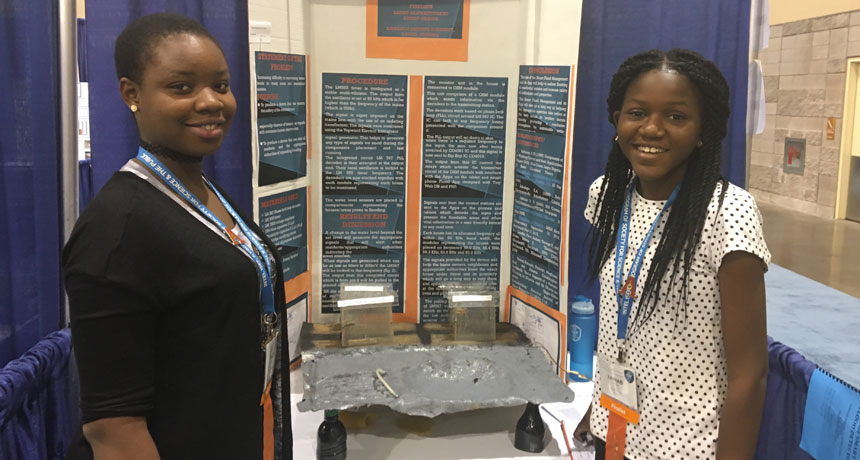Teens share what inspired them in STEM
Finalists at the Intel International Science and Engineering Fair share their Eureka! moments

Zainab Oluwafeyisayo Badru (right) and Gracia Enghonghon Adudu (left) developed an app to warn people about local floods in real time.
B. Brookshire/SSP
Share this:
- Share via email (Opens in new window) Email
- Click to share on Facebook (Opens in new window) Facebook
- Click to share on X (Opens in new window) X
- Click to share on Pinterest (Opens in new window) Pinterest
- Click to share on Reddit (Opens in new window) Reddit
- Share to Google Classroom (Opens in new window) Google Classroom
- Click to print (Opens in new window) Print
PHOENIX, Ariz. — Research projects here at the Intel International Science and Engineering Fair cover nearly every field imaginable. For example, two girls designed a phone app that can send notify people when neighborhoods have begun to flood. Many other projects focus on treating deadly diseases, developing clever robots or making stronger construction materials. And the inspirations behind all of these projects are diverse as well. Some students wanted to solve local problems. Others got their inspiration from family members. Still others can thank their teachers for getting them started.
All ended up together, here, at the 2016 Intel ISEF, or International Science & Engineering Fair. Created by Society for Science & the Public and sponsored by Intel, this year’s competition brought together more than 1,600 students from more than 70 countries. (The Society also publishes Science News for Students and this blog.)
Here, in their own words, five of this year’s competitors talk about how they got inspired to pursue their projects.
I was inspired to do science because I wanted to solve the problems of the world, especially flooding.
— Zainab Oluwafeyisayo Badru, 13, Doregos Private Academy, Lagos, West Africa, Nigeria
Zainab and her partner Gracia Enghonghon Adudu developed that phone app to warn people when flood waters have triggered sensors in neighborhood homes.
We were inspired because nowadays heavy metal pollution has become a big problem. We wanted to make a contribution to the environment. It’s kind of like volunteering.
— Heying Shen, 14, and Zixuan Zhi, 16, Guangdong Experimental High School, GuangZhou, Guangdong, China
Heying and Zixuan developed a microbial fuel cell — a device that uses microbes to generate electricity. It removes heavy metals (such as lead) from water.
I am passionate about science because of my grandmother. She inspired me to do research and pursue STEM [science, technology, engineering and math].
— Liam Bernard Kimel, 18, Hakfar Hayarok Environmental Leadership High School, Ramat HaSharom, HaMerkaz, Israel
Liam worked on Pseudomonas aeruginosa. This bacterium can cause nasty infections in people. He studied what makes the bacteria virulent — or capable of causing disease.
What inspired me to get into science was my science teacher, Ms. Price, from ninth grade….Science isn’t something that’s constrained to an ivory tower. It’s problem-solving, trying to do all sorts of crazy things.
— Sophia Edith Swartz, 16, Central Bucks High School South, Warrington, Penn.
Sophia developed a new lab plate to grow many lettuce seeds at once. Her goal is to study their genes — the instructions that control how these plants look and grow.
Follow Eureka! Lab on Twitter
Power Words
(for more about Power Words, click here)
app Short for application, or a computer program designed for a specific task.
application A particular use or function of something.
gene (adj. genetic) A segment of DNA that codes, or holds instructions, for producing a protein. Offspring inherit genes from their parents. Genes influence how an organism looks and behaves.
genetic Having to do with chromosomes, DNA and the genes contained within DNA. The field of science dealing with these biological instructions is known as genetics. People who work in this field are geneticists.
infectious An adjective that describes a type of germ that can be transmitted to people, animals or other living things.
lead A toxic heavy metal (abbreviated as Pb) that in the body moves to where calcium wants to go. The metal is particularly toxic to the brain, where in a child’s developing brain it can permanently impair IQ, even at relatively low levels.
microbial fuel cell A device that relies on microbes to initiate a chemical reaction to generate electricity. These devices can use waste materials, including sewage and manure, to produce energy cleanly. (see also fuel cell)
Pseudomonas aeruginosa This common bacterium, whose name is sometimes shortened to P. aeruginosa, can cause disease in animals, including people. It lives in soil and water, and it is also can live on human skin. Under normal conditions it is harmless, but in certain cases its infections may turn deadly.
virulence (in medicine) The potency of a virus, bacterium or other agent in causing infectious disease. Among a given species, some strains may cause disease with very little exposure (such as infection with a few cells). Less virulent strains may take massive exposures to create disease.